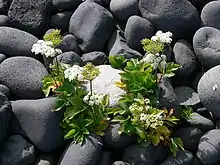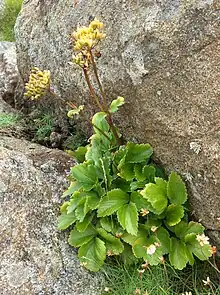Ligusticum scoticum
Ligusticum scoticum, known as Scots lovage,[3] or Scottish licorice-root,[4] is a perennial flowering plant in the celery family Apiaceae (previously Umbelliferae) found near the coasts of northern Europe and north-eastern North America. It grows up to 60 centimetres (24 in) tall and is found in rock crevices and cliff-top grassland. It is closely related to, and possibly conspecific with, Ligusticum hultenii from the coast of the northern Pacific Ocean. The plant is edible and contains the compound sotolon, which is also present in fenugreek.[5] The leaves have a flavour similar to parsley or celery, while the seeds taste similar to fenugreek or cumin.[5]
| Ligusticum scoticum | |
|---|---|
 | |
| Ligusticum scoticum on a beach in Iceland | |
| Scientific classification | |
| Kingdom: | Plantae |
| Clade: | Tracheophytes |
| Clade: | Angiosperms |
| Clade: | Eudicots |
| Clade: | Asterids |
| Order: | Apiales |
| Family: | Apiaceae |
| Genus: | Ligusticum |
| Species: | L. scoticum |
| Binomial name | |
| Ligusticum scoticum | |
| Synonyms [2] | |
| |
Description
Ligusticum scoticum is a herbaceous perennial plant which typically grows 15–60 centimetres (6–23+1⁄2 in) tall. It has triangular, twice-ternate leaves, 5–20 cm (2–7+7⁄8 in) long, with each lobe 2–5 cm (3⁄4–2 in) long. The edges of the leaves may be toothed, lobed or serrated, and are typically either a paler green or magenta. The stem branches infrequently, and bears 2–5 inflorescences, each of which is a compound umbel 4–6 cm (1+1⁄2–2+1⁄4 in) in diameter. There are typically 8–12 rays in both the primary and secondary umbels. Each individual flower is around 2 mm (1⁄16 in) in diameter and greenish-white in colour The fruit are 4–6 mm (3⁄16–1⁄4 in) long, with five prominent ridges on each carpel.[2]
Ligusticum scoticum tastes and smells like parsley[2] or celery.[6]
Distribution
Ligusticum scoticum is primarily an Arctic plant, with a disjunct range extending from northern Norway to the more northerly shores of the British Isles, and from western Greenland to New England.[7] A related species, Ligusticum hultenii, which was described by Merritt Lyndon Fernald in 1930[8] and may be better treated as a subspecies of L. scoticum, occurs around the northern Pacific Ocean, from Japan to Alaska.[3] The southernmost occurrence of L. scoticum is at Ballyhalbert in Northern Ireland.[3]
Ecology

Within the British Isles, Ligusticum scoticum is only found on coasts where the mean July temperature is below 15 °C (59 °F), and this bound is likely also to apply in other parts of the species' range. Towards the southern end of its range, the plant performs poorly on south-facing sites. It grows in fissures in rocks, where it may be the only vascular plant, and also in cliff-top grassland communities dominated by Festuca rubra and Plantago maritima.[2]
Ligusticum scoticum cannot tolerate grazing, and is harmed by the actions of nesting seabirds; it is therefore rarely found on bird cliffs, or where grazing sheep and rabbits are found. It is, however, tolerant of salt spray, and its growth has been shown to improve when given dilute sea water. The leaves of L. scoticum are frost-tolerant, and die back each winter, but regrow very rapidly the following spring. In the British Isles, flowering occurs from June to August, and the seeds are ripe in October or November; the timing is expected to be later at higher latitudes. The flowers of L. scoticum are visited by generalist pollinators, mostly flies.[2]
Taxonomy
Ligusticum scoticum was first described by Carl Linnaeus in his 1753 work Species Plantarum.[9] Linnaeus originally used the epithet scothicum, and this is used by many authors in North America; in Europe, the amended spelling scoticum is used.[2]
Uses
The plant was formerly widely eaten in western Britain, both for nutrition and to combat scurvy.[6] The leaves and stalks are edible before the flowers appear, and contain vitamin A and C.[10] They can be consumed raw or cooked like celery. Additionally, the young shoots can be candied.[10]
References
- Meredith, C. R.; Applequist, W. L. (2020). "Ligusticum scoticum". IUCN Red List of Threatened Species. 2020: e.T117002531A138134762. doi:10.2305/IUCN.UK.2020-3.RLTS.T117002531A138134762.en. Retrieved 19 November 2021.
- Palin, M. Anne (1988). "Ligusticum scoticum L. (Haloscias scoticum (L.) Fr.)". Journal of Ecology. 76 (3): 889–902. doi:10.2307/2260580. JSTOR 2260580.
- Hackney, Paul. "Ligusticum scoticum – scots lovage". Northern Ireland Priority Species. National Museums Northern Ireland. Retrieved October 18, 2013.
- USDA, NRCS (n.d.). "Ligusticum scoticum". The PLANTS Database (plants.usda.gov). Greensboro, North Carolina: National Plant Data Team. Retrieved 2 June 2015.
- "Wild Spices of the UK". Galloway Wild Foods. Retrieved 12 July 2022.
- Watts, D. C. (2007). "Lovage". Dictionary of Plant Lore. Academic Press. p. 231. ISBN 9780080546025.
- Crawford, R. M. M. (2008). Plants at the Margin: Ecological Limits and Climate Change. Cambridge University Press. pp. 73, 235. ISBN 9781139469296.
- Fernald, Merritt Lyndon (1930). "Ligusticum scothicum of the North Atlantic and of the North Pacific". Contributions from the Gray Herbarium of Harvard University. 87 (87): 7–9. doi:10.5962/p.336117. JSTOR 41764456. S2CID 249086302.
- "Plant Name Details−Apiaceae Ligusticum scoticum L." International Plant Names Index. Retrieved 7 November 2012.
- Angier, Bradford (1974). Field Guide to Edible Wild Plants. Harrisburg, PA: Stackpole Books. p. 196. ISBN 0-8117-0616-8. OCLC 799792.
External links
 Media related to Ligusticum scoticum at Wikimedia Commons
Media related to Ligusticum scoticum at Wikimedia Commons
